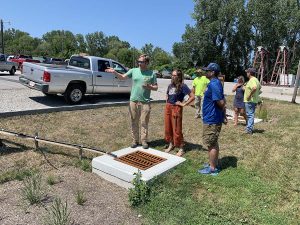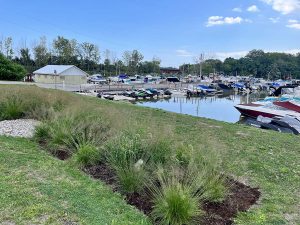
New Toolkit Defines and Refines Stormwater Control
Published on May 2, 2024Sea level rise, climate change, severe storms, flooding—all these terms are part of the vocabulary for anyone who lives near a body of water. Another term that’s often interspersed with these words is stormwater, but defining exactly what stormwater is or why it matters, may not be widely understood. For three years now, a team from Ohio, Michigan and Wisconsin Sea Grants, along with Clean Marina programs in those states, have been working hard to ensure marinas on any coast understand what stormwater is and what they can do to control it.
In 2018, these organizations received nearly $900,000 in funding from the Great Lakes Protection fund to develop a marina-specific stormwater management decision support tool and pilot the installation of green infrastructure at a few public and private marinas. Marina Dock Age covered this project when it was first introduced and checked back in now to see how the project has progressed.
Sarah Orlando, extension educator and clean marina program manager at Ohio State University, explained the initial concept was to place green infrastructure at marinas to provide real-world examples of stormwater management tools. The team of researchers on the project conducted a needs assessment and realized that just having tools in place to see wasn’t enough. “We were adamant that we wrote this with the marinas in mind, which is why we did a needs assessment with marinas to find out what they knew about stormwater and bioretention. If they don’t know the concepts, we feared they would shut down and stop listening, so we made it common sense and tested it with marinas on how much it made sense,” Orlando said.
From the assessment, it became clear that a critical component needed to be the creation of a public outreach tool to bridge the gap between marinas that had heard of stormwater and green infrastructure but had no idea why stormwater mattered nor how controlling would look on their properties. The project expanded to include education and outreach, as well as implementation and monitoring.

Three Purposes
The result is the stormwater toolkit with three distinct purposes. There’s a learning section which is essentially a beginner course on what stormwater and green infrastructure is and a list of best practices. There’s a matrix of different types of stormwater management options, in what scenario each would work best, maintenance requirements, and a cost range for installation.
The visualize tab leads to a series of photos and graphics that show what stormwater management tools look like in practice. Finally, the website has a build section that offers resources and guidance to help marinas find solutions that work best on their unique properties.
Orlando said the toolkit is not meant to give marinas information and assume they will construct a bioswale or wetland on their property that resolves any stormwater issues they have. “We wanted to give marinas resources and some guidance to find help. We give them enough information to understand the concept but encourage them to find someone to help them customize a solution that really works for their site,” Orlando said.
While marinas may balk at hiring help, Orlando said there are many free places to turn to, starting with state Sea Grant offices and Clean Marina programs. She said local stormwater conservation districts are also available and any of these services will likely be free. Because of how prominent stormwater has become to municipalities, local offices are a good place to start to look for assistance “There’s so much technical expertise out there in state and local agencies, she said. “Universities are filled with people who are in this field every day and can help marinas find the best tool.”
The project completed demonstration projects at four marinas across three states and with a mix of private and public facilities. It was important to the researchers to include private marinas. Orlando argued for this, citing that public marinas have crews and funding that private marinas may not. “Paying for green infrastructure out of your own pocket and installing it yourself is different than having a team and public funding behind you,” she said.
The goal of the green infrastructure installations was to make it relevant and realistic for any marina, whether coastal or inland. “We didn’t develop this in a silo even though we’re scientists. We involved the end user from beginning to end,” Orlando said. As an example, Orlando explained that early on, their design consultant created a beautiful rain garden with about 10 different plant species. The marina owner agreed it was beautiful but asked how he would be able to identify what was a plant or weed and how the plants should be trimmed. “We realized that our solutions had to be functional more than beautiful, so for this site we used just two plant species that turned out to be incredible for improving water quality. It’s not fancy but it’s easier to maintain and a more realistic solution,” she said. It was also important to show that building green infrastructure is not only possible but feasible.

Monitoring the Results
With the stormwater tools in place, the researchers began monitoring the results, looking at both water quantity and quality. A single group of scientists from Ohio State University did all the monitoring and processing of data using every bit of time in the past three years to compile results. The monitoring closed at the end of 2023, and early results have shown the green infrastructure has had positive impacts at all four marinas. Both bioretention cells and high rate biofilters were used in the projects. Biorention cells reflect runoff with flow-regulating underdrains, while biofilters remove stormwater through infiltration into surrounding soils. Both options reduced stormwater volumes, peak flow rates and pollutant loads of sediment, nutrients, and heavy metals. The biorention cells provided greater hydrologic and water quality treatment, but the small footprint of the bioinfiltration option makes it more versatile for future projects. Marinas would need to weigh the pros and cons and select a practice that addresses the specific stormwater management concerns at the site.
Orlando said many marinas were surprised to hear they were looking at water quantity as well as quality. “I had people say that excess water just runs back into the lake so why does this matter. I had to have them look at where running water erodes parts of their property, or I questioned whether they had problems with parking lots freezing and cracking over the winter because water pooled,” she said. “I gave them examples of why it’s not just how the water looks but what it does that matter.”
The number of pollutants and water retention that the rain gardens, wetlands, rain barrels, etc. captured and percolated was surprising. The real data gives marinas a clearer understanding of why stormwater management is important and that it does make a difference.
Orlando envisions the toolkit being used by a marina that has an erosion or flooding problem, or that needs to meet the requirements for a stormwater plan. This would be a starting point to learn more about stormwater issues and solutions. Coming soon to the site will be case studies that show real-life marina stormwater issues and what was done to remedy the problem. While the toolkit was developed in Great Lakes states, it can be tweaked to reflect specific environments and rules of any state, coastal or inland. Orlando and her team are in the early stages of spreading the word about its availability, with the goal to have marinas across the nation well-versed in stormwater and why it matters.
| Categories | |
| Tags |





